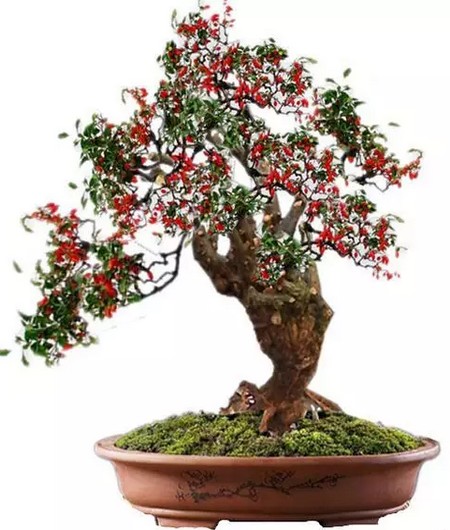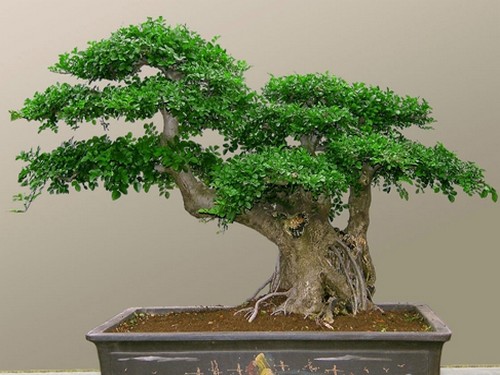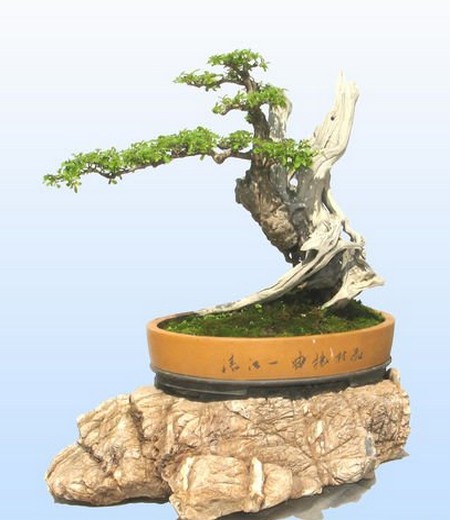How to make Chinese wolfberry bonsai
Spring, a season of recovery of all things, people want to raise several pots of flowers in this season, not only beautify the home, but also edify the sentiment, and bonsai is one of the best, but the price is naturally expensive, have you ever thought of making a bonsai yourself? Lycium barbarum is a specialty of Ningxia. In ancient times, it was one of the bonsai Rocks of Eighteen Scholars. Lycium barbarum stump bonsai posture is elegant, branches overhang, flowers purple, into the autumn red fruit covered with branches, ornamental effect is very good. Today we share with you how to make Chinese wolfberry bonsai.

Chinese wolfberry bonsai is generally made of old tree stumps. Old tree stumps can be made into various forms of bonsai. However, its branches are long and there are few fruits on the short branches, so it is difficult for other forms of bonsai except hanging branches to show a scene of numerous fruits on the ideal branches.
Chinese wolfberry has two growth periods and two dormancy periods in a year, the dormancy period is cold winter and hot dog days respectively, the winter dormancy period is about four months, and the dormancy period of dog days is one month. This growth period is divided into the first half of the growth period and the second half of the growth period, the first half of the growth period is mainly vegetative growth, only growing branches and leaves do not blossom and bear fruit, the second half of the growing period is mainly reproductive growth, while growing branches and leaves bloom and bear fruit at the same time.
According to this characteristic, we can give it more long branches and leaves during its growth in the first half of the year, without pruning, so that it can store more nutrients, and trim it during a short dormant period in the summer. In the second half of the growing period, through pinching, pinching, acupuncture and other techniques to make it more branched, branches early aging, more flowering, so that you can enjoy the red fruit of Chinese wolfberry bonsai.
1. Processing: the main branches of Chinese wolfberry can be properly clambered and pruned. Large branches should be clambered and pruned in winter, while branchlets can be climbed in summer and autumn. The new branch can be clamped up at any time with suitable wire such as iron, lead and copper. Lycium barbarum wood is brittle, pay attention to soft force during operation, not too fierce.
2. Tree shape: the old pile bonsai of Chinese wolfberry should be made into curved dry type or cliff type, while the twigs should be tied into drooping shape. Tigan shape can be made into bridge-crossing style. There are other forms, such as the root-lifting type, the multi-dry type, the strange type and so on, of which those with a big head and a small tail and a straight one are the most boring. All in all, because of the tree shape, apply art in accordance with their aptitude, repeatedly knock, do not act in undue haste.
In winter, Chinese wolfberry bonsai should overwinter outdoors, especially cold places can be used for thermal protection of bonsai bonsai. Prune the leaf buds when they sprout in early spring, and then keep them in a place with good ventilation and plenty of light. When the new branches and leaves grow, the dilute liquid fertilizer dominated by nitrogen is applied once a week, during this growth process, do not prune the branches and leaves, let them grow, make the branches stout, and store more nutrients in the stump. Of course, in the meantime, you can tie the branches according to the modeling needs.
It will be dormant for a short time when it is hot and dry in the summer. This dormancy should keep the basin soil dry, do not apply fertilizer, and let it be pruned after dormant for a month or so. After the new branches and leaves grow, they should apply dilute liquid fertilizer dominated by phosphorus and potassium once a week. Fertilizing can be watered more on the second day, and water should be deducted the rest of the time. When the new branch grows to 2-3 cm long, it can be pinched once or twice a day according to the direction of the intended branch. When pinching the branch, it should be gently pinched and bent to a small extent, and then gradually increase the curvature. This can make the branches aging and promote flower bud differentiation. Pinching branches can also be pinched according to requirements.
If individual branches grow faster than they are intended to grow, you can use small needles to stick one or two needles between the two leaves of the growing section of the branches, reaching deep into the center of the branches, which can slow down the growth of the branches and shorten the branches. If the growth is still too fast, you can draw the vertical branches with a needle under the petiole, not too deep, which is actually the ring cutting in the technology of cultivated fruit trees.
After this management to the Mid-Autumn Festival, you can enjoy a pot of Chinese wolfberry bonsai full of red fruit. After winter, the red fruit can be hung in a cold room with light until after New Year's Day. If you want to have numerous red fruits every year, you should also change into the nutritious soil every year. When changing the soil in early spring, add some bone powder and dealkaline lime powder to increase calcium, because Chinese wolfberry likes the soil with high calcium.
There are all kinds of beauty in life, and some of them need us to participate in order to fully understand, move our hands, to experience different scenery!
Chinese wolfberry is not only a valuable traditional Chinese medicine, its root is also a very exquisite bonsai material, the ancients gave its bonsai Rocks of Eighteen Scholars one of the good name. The root of Chinese wolfberry is clumsy and interesting, vicissitudes without losing its charm, it is easy to form drought-resistant, easy to feed and prune, red fruit dotted in the green leaves intriguing, fruit setting time from October to March next year, is very beautiful.
There are wild Chinese wolfberry in many places, but many people ignore its other beauty, because its branches have small thorns, the branches are slender and soft, and they are not careful to be stabbed, so it has been silently offering its priceless fruit to people.
The Chinese wolfberry stump can be made into various forms of bonsai according to the producer's idea. However, its branches are long, like vines, and there is little fruit on the short branches, so it is difficult for other forms of bonsai except hanging branches to show a scene of numerous fruits on the ideal branches. Experienced bonsai masters infer that Chinese wolfberry trees with a diameter of 3 cm are generally about 15 years old, so it is still a preferred species for balcony groups to play with.
Chinese wolfberry has two growth periods and two dormant periods in a year, which are cold winter and hot dog days respectively. The dormancy period in winter is about four months, and the dormancy period in dog days is one month. This growth period is divided into the first half of the growth period and the second half of the growth period, the first half of the growth period is mainly vegetative growth, only growing branches and leaves do not blossom and bear fruit; the second half of the growing period is mainly reproductive growth, blooming and fruiting at the same time of growing branches and leaves.
According to this characteristic, during its growth in the first half of the year, it was given heavy water and fertilizer to make its branches and leaves grow, without pruning, to store more nutrients, and to trim it during a short dormant period in the summer days. In the second half of the year, through pinching and pinch branches and other techniques to make it more branched, branches early aging, more flowering, so that you can enjoy the red fruit want to drop Chinese wolfberry bonsai.
In winter, Chinese wolfberry bonsai should overwinter outdoors, especially cold places can be used for thermal protection of bonsai bonsai. Prune the leaf buds when they sprout in early spring, and then keep them in a place with good ventilation and plenty of light.
When the new branches and leaves grow, the dilute liquid fertilizer dominated by nitrogen is applied once a week, during this growth process, do not prune the branches and leaves, let them grow, make the branches stout, and store more nutrients in the stump. Of course, in the meantime, you can tie the branches according to the modeling needs.
It will be dormant for a short time when it is hot and dry in the summer. This dormancy should keep the basin soil dry, do not apply fertilizer, and let it be pruned after dormant for a month or so. Once a week after the new leaves grow, they will apply dilute liquid fertilizer dominated by phosphorus and potassium. Fertilizing can be watered more on the second day, and water should be deducted the rest of the time. When the new branch grows to 2-3 cm long, it can be pinched once or twice a day according to the direction of the intended branch. When pinching the branch, it should be gently pinched and bent to a small extent, and then gradually increase the curvature. This can make the branches aging and promote flower bud differentiation.
Pinching branches can also be pinched according to requirements. If individual branches grow faster than they are intended to grow, you can use small needles to stick one or two needles between the two leaves of the growing section of the branches, reaching deep into the center of the branches, which can slow down the growth of the branches and shorten the branches; if the growth is still too fast, you can cut the vertical branches with a needle under the petiole, not too deep, which is actually the ring cutting in the technology of cultivated fruit trees. By the Mid-Autumn Festival, you can enjoy a pot of Chinese wolfberry bonsai full of red fruits.
After winter, the red fruit can be hung in a cold room with light until after New Year's Day. If you want to have numerous red fruits every year, you should also change into the nutritious soil every year. When changing the soil in early spring, add some bone powder and dealkaline lime powder to increase calcium, because Chinese wolfberry likes the soil with high calcium.
Time: 2019-05-26 Click:
- Prev

Key points and matters needing attention in the production of white wax bonsai
As an ornamental cherished plant, White Wax is the only rare tree species left in the world today, which is called living fossil. Main points of production: 1. Mining: same as conventional. 2. Pile repair: put the pile in place at once, flatten the branches, roots and wounds, and seal. Soak with disinfection and root promoter for 10-15 hours
- Next

The making method of Bauhinia bonsai
Bauhinia, deciduous shrubs or small trees, Verbenaceae, Bauhinia, there are about 200 species of this genus, Bauhinia is one of them. Bauhinia is a good tree species for making and cultivating bonsai. Bauhinia can make various forms of tree stump bonsai
Related
- Fuxing push coffee new agricultural production and marketing class: lack of small-scale processing plants
- Jujube rice field leisure farm deep ploughing Yilan for five years to create a space for organic food and play
- Nongyu Farm-A trial of organic papaya for brave women with advanced technology
- Four points for attention in the prevention and control of diseases and insect pests of edible fungi
- How to add nutrient solution to Edible Fungi
- Is there any good way to control edible fungus mites?
- Open Inoculation Technology of Edible Fungi
- Is there any clever way to use fertilizer for edible fungus in winter?
- What agents are used to kill the pathogens of edible fungi in the mushroom shed?
- Rapid drying of Edible Fungi

